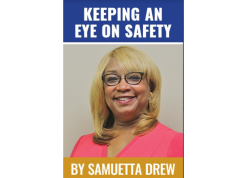Synthetic Cannabinoid Users Can Exhibit Bizarre and Violent Behaviors
Hospitalizations after use increase in Alabama over past week
The Alabama Department of Public Health has received reports of an increase in 9-1-1 calls, and Alabama hospitals have reported five deaths and an increase in emergency room visits by patients presenting with symptoms consistent with exposure to synthetic cannabinoids, commonly referred to as “spice.” These drugs are being used alone or in combination with other drugs.
Between March 15 and May 4, at least 932 patients who have ingested or smoked these substances have been seen, 196 patients have been hospitalized, and five have died. People hospitalized ranged in age from early teens through the 60s. Surveillance began on April 15, and prior to that date hospitals provided approximate date ranges and numbers of patients seen.
Users not only harm themselves but pose a threat to others. “We have been informed about how violent people under the influence of synthetic cannabinoids can be not only posing a danger to themselves but also to those around them,” Assistant State Health Officer Dr. Mary McIntyre said. “Their behavior may be bizarre and violent, so if you encounter someone you suspect is under the influence of spice, call 9-1-1 at once.”
Symptoms spice users exhibit include the following:
· Severe agitation, hyperactivity and anxiety
· Racing heartbeat and elevated blood pressure
· Muscle spasms, seizures and tremors
· Intense hallucinations and psychotic episodes
· Coma
Users of synthetic marijuana can experience these symptoms or others, with varying intensity. Because there is no control of the types or amount of chemicals contained, users have no way of knowing what they are ingesting. Analyses done in other states have shown not only the presence of synthetic cannabinoids but other chemicals including amphetamines and methamphetamine, cocaine, and Lovamisole (an animal dewormer), creating a toxic combination.
Dr. McIntyre said, “I was informed of a recent incident in which a spice user was pacing and shouting, and appeared to experience a seizure on the sidewalk while waiting for law enforcement and emergency medical personnel to arrive.”
Furthermore, Dr. McIntyre reminded the public not to risk their lives by using synthetic cannabinoid products that are highly unpredictable and whose long-term health effects are unknown.
Health care providers statewide have been asked to consider exposure to synthetic cannabinoids as a possibility for patients presenting with severe illness. These patients will have self-reported or suspected synthetic cannabinoid or synthetic marijuana use within 24 hours of onset of illness with or without other recreational substances (probable case) or will have suspected use of unknown recreational drugs within 24 hours of onset of illness, along with a compatible clinical presentation (suspect case).
Certain hospital emergency rooms have been asked to provide weekly reports of numbers and ages of affected patients to the ADPH Epidemiology Division. These reports are collected weekly.
The designer drug substances consist of dried plant material sprayed with synthetic cannabinoids and various mixtures of other unknown chemicals including pesticides and rat poison. The chemical compounds reportedly stimulate the same brain areas affected by marijuana, and they have a high potential for abuse. Users may opt for these marijuana alternatives because they mistakenly believe the substances are safe.
Names for synthetic cannabinoids include Spice, K2, Spice Gold, Sence, Genie, Zohai, Yucatan Fire, Smoke, Black Mamba and Skunk.



